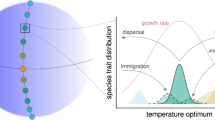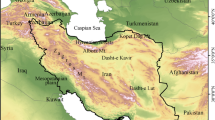Abstract
Arising from: C. D. Thomas et al. Nature 427, 145–148 (2004); see also communication from Buckley & Roughgarden and communication from Harte et al.;Thomas et al. reply Thomas et al.1 model species-distribution responses to a range of climate-warming scenarios and use a novel application of the species–area relationship to estimate that 15–37% of modelled species in various regions of the world will be committed to extinction by 2050. Although we acknowledge the efforts that they make to measure the uncertainties associated with different climate scenarios, species' dispersal abilities and z values (predictions ranged from 5.6% to 78.6% extinctions), we find that two additional sources of uncertainty may substantially increase the variability in predictions.
Similar content being viewed by others
Enjoying our latest content?
Log in or create an account to continue
- Access the most recent journalism from Nature's award-winning team
- Explore the latest features & opinion covering groundbreaking research
or
References
Thomas, C. D. et al. Nature 427, 145–148 (2004).
Thuiller, W. Global Change Biol. 9, 1353–1362 (2003).
Brown, J. H. & Lomolino, M. V. Biogeography 2nd edn (Sinauer, Sunderland, Massachusetts, 1998).
Nakicenovic, N. & Swart, R. Emissions Scenarios: A special report of working group III of the Intergovernmental Panel on Climate Change (Cambridge Univ. Press, Cambridge, 2000).
Author information
Authors and Affiliations
Corresponding author
Rights and permissions
About this article
Cite this article
Thuiller, W., Araújo, M., Pearson, R. et al. Uncertainty in predictions of extinction risk. Nature 430, 34 (2004). https://doi.org/10.1038/nature02716
Issue date:
DOI: https://doi.org/10.1038/nature02716
This article is cited by
-
Climate warming and dispersal strategies determine species persistence in a metacommunity
Theoretical Ecology (2022)
-
Uncertainty in ensembles of global biodiversity scenarios
Nature Communications (2019)
-
Extinction risks of a Mediterranean neo-endemism complex of mountain vipers triggered by climate change
Scientific Reports (2019)
-
Evidence and mapping of extinction debts for global forest-dwelling reptiles, amphibians and mammals
Scientific Reports (2017)
-
The potential range of Ailanthus altissima (tree of heaven) in South Africa: the roles of climate, land use and disturbance
Biological Invasions (2017)



